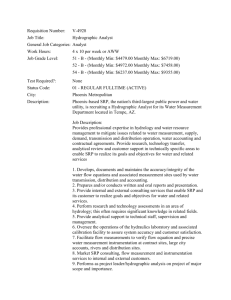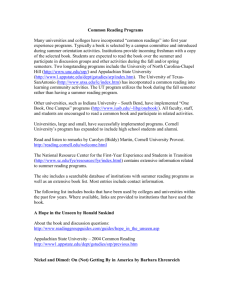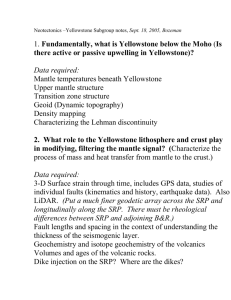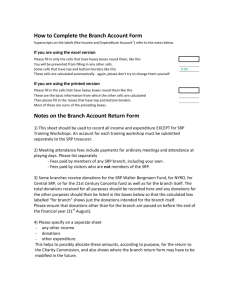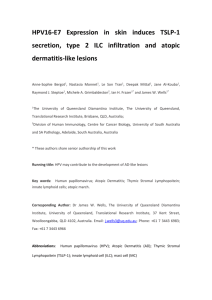The completion of the classification of the regular near
advertisement
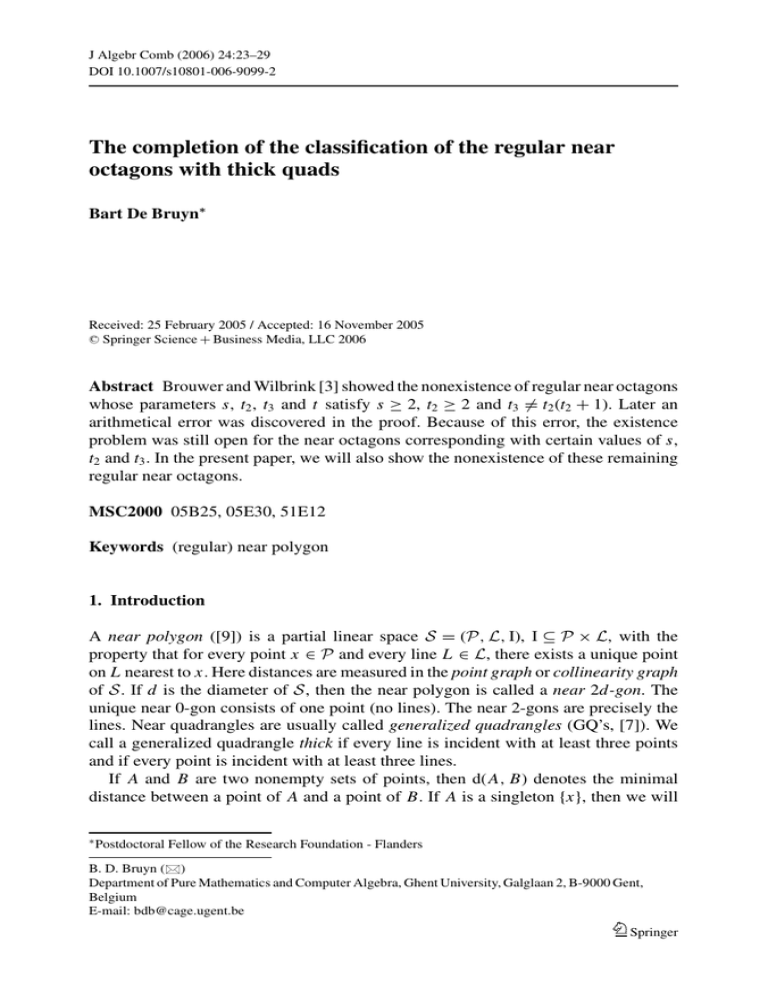
J Algebr Comb (2006) 24:23–29
DOI 10.1007/s10801-006-9099-2
The completion of the classification of the regular near
octagons with thick quads
Bart De Bruyn∗
Received: 25 February 2005 / Accepted: 16 November 2005
C Springer Science + Business Media, LLC 2006
Abstract Brouwer and Wilbrink [3] showed the nonexistence of regular near octagons
whose parameters s, t2 , t3 and t satisfy s ≥ 2, t2 ≥ 2 and t3 = t2 (t2 + 1). Later an
arithmetical error was discovered in the proof. Because of this error, the existence
problem was still open for the near octagons corresponding with certain values of s,
t2 and t3 . In the present paper, we will also show the nonexistence of these remaining
regular near octagons.
MSC2000 05B25, 05E30, 51E12
Keywords (regular) near polygon
1. Introduction
A near polygon ([9]) is a partial linear space S = (P, L, I), I ⊆ P × L, with the
property that for every point x ∈ P and every line L ∈ L, there exists a unique point
on L nearest to x. Here distances are measured in the point graph or collinearity graph
of S. If d is the diameter of S, then the near polygon is called a near 2d-gon. The
unique near 0-gon consists of one point (no lines). The near 2-gons are precisely the
lines. Near quadrangles are usually called generalized quadrangles (GQ’s, [7]). We
call a generalized quadrangle thick if every line is incident with at least three points
and if every point is incident with at least three lines.
If A and B are two nonempty sets of points, then d(A, B) denotes the minimal
distance between a point of A and a point of B. If A is a singleton {x}, then we will
∗ Postdoctoral
Fellow of the Research Foundation - Flanders
B. D. Bruyn ()
Department of Pure Mathematics and Computer Algebra, Ghent University, Galglaan 2, B-9000 Gent,
Belgium
E-mail: bdb@cage.ugent.be
Springer
24
J Algebr Comb (2006) 24:23–29
also write d(x, B) instead of d({x}, B). If A is a nonempty set of points and if i ∈ N,
then we denote by i (A) the set of points y for which d(y, A) = i. If A is a singleton
{x}, then we also write i (x) instead of i ({x}).
A near 2n-gon, n ≥ 1, is said to have order (s, t) if every line is incident with
precisely s + 1 points and if every point is incident with precisely t + 1 lines. A
near 2n-gon, n ≥ 1, is called regular if its point graph is a so-called distance-regular
graph ([2]), or equivalently, if it has an order (s, t) and if there exists constants ti ,
i ∈ {0, . . . , n}, such that for any two points x and y at distance i from each other,
there are precisely ti + 1 lines through y containing a point at distance i − 1 from x.
Obviously, t0 = −1, t1 = 0 and tn = t.
A sub near polygon S of a near polygon S is called geodetically closed if it satisfies
the following properties:
(i) the points of S determine a subspace of S;
(ii) every point of on a shortest path (in S) between two points of S is again a point
of S .
A near polygon is called dense if every line is incident with at least three points
and if every two points at distance 2 have at least two common neighbours. By [3,
Theorem 4], every two points of a dense near polygon at distance δ from each other are
contained in a unique geodetically closed sub near 2δ-gon. These sub near polygons
are called quads if δ = 2 and hexes if δ = 3.
In [3, Theorem 7], Brouwer and Wilbrink showed the nonexistence of regular near
octagons whose parameters s, t2 , t3 and t satisfy the following conditions: s ≥ 2, t2 ≥ 2
and t3 = t2 (t2 + 1). Later an arithmetical error was discovered in the proof (lines 5
and 6 of page 172), causing a gap in the proof. The authors of [2] ask in their book to
fill this gap (see page 206) and in the present paper we will do that.
The regular near octagons which still need to be ruled out all have parameters of the
following form: t2 = q, s = q 2 and q 4 + q 3 + 2q ≤ t3 ≤ q 4 + q 3 + q 2 + 2q + 18.
The lower bound for t3 arises from the divisibility condition t2 | t3 and the inequality
t3 + 1 > (t2 + 1)(st2 + 1) which are know to hold for any nonclassical dense regular
near hexagon which is not isomorphic to the M24 near hexagon. We will rule out
the remaining regular near octagons by improving this lower bound for t3 + 1 and
subsequently dealing with the remaining cases. As a consequence, we have
Theorem 1 ([3, Theorem 7] + Section 4). There exist no regular near octagons
whose parameters s, t2 , t3 and t satisfy s ≥ 2, t2 ≥ 2 and t3 = t2 (t2 + 1).
2. Some properties of generalized quadrangles
As we mentioned before the generalized quadrangles are precisely the near quadrangles. Any generalized quadrangle which is not degenerate, not a grid and not a dual
grid must have a certain order (s, t2 ). The aim of this section is to collect some known
and easy properties of generalized quadrangles.
Lemma 1 ([7, 1.2.2 and 1.2.3]). If Q is a generalized quadrangle of order (s, t2 ), then
Springer
J Algebr Comb (2006) 24:23–29
25
r s + t2 | st2 (s + 1)(t2 + 1);
r s ≤ t 2 if t2 = 1, or dually, t2 ≤ s 2 if s = 1 (Higman’s inequality).
2
Lemma 2 ([7, 2.2.1]). If Q is a generalized quadrangle of order (s, t2 ) and if Q is a
proper subquadrangle of order (s, t2 ) of Q, then t2 ≤ ts2 . Equality holds if and only if
every line of Q meets Q .
Lemma 3 ([7, 2.3.1]). Let Q be a generalized quadrangle of order (s, t2 ), s = 1, and
let X be a nonempty set of points of Q. If every line of Q which has at least two points
in common with X is completely contained in X , then X is one of the following sets:
(a) a set of mutually noncollinear points;
(b) the set of points on a pencil of lines (i.e. a set of lines through a distinguished
point);
(c) the set of points of a subquadrangle of order (s, t2 ).
3. Restrictions on the parameters of regular near hexagons
Let S be a regular near hexagon with parameters s, t2 and t3 and let A denote the
collinearity matrix of S. There exist well-known techniques for calculating the eigenvalues and corresponding multiplicities of A, see e.g. [2] or Section 7 of [8]. The graph
A has four distinct eigenvalues λi , i ∈ {0, 1, 2, 3}, with −(t3 + 1) = λ0 < λ1 < λ2 <
λ3 = s(t3 + 1). Here λ1 and λ2 are the roots of the quadratic polynomial
X 2 − (s − 1)(t2 + 2)X + (s 2 − s + 1)t2 − st3 + (s − 1)2 .
The multiplicity f 3 of the eigenvalue s(t3 + 1) is equal to 1. The multiplicity f 0 of the
eigenvalue −(t3 + 1) is equal to
s3
(t2 + 1) + st3 (t2 + 1) + s 2 t3 (t3 − t2 )
,
s 2 (t2 + 1) + st3 (t2 + 1) + t3 (t3 − t2 )
and the multiplicity f 3−i of the eigenvalue λ3−i , i ∈ {1, 2}, is equal to
λi (m − 1) + s(t3 + 1) − (λi + t3 + 1) f 0
,
λi − λ3−i
where
m = 1 + s(t3 + 1) +
s 2 (t3 + 1)t3
s 3 t3 (t3 − t2 )
+
.
t2 + 1
t2 + 1
The fact that all these multiplicities are integers gives already severe restrictions on
the parameters. Another restriction is the so-called Mathon bound ([3, 5, 6]) which
holds if s = 1:
t3 ≤ s 3 + t2 (s 2 − s + 1).
Springer
26
J Algebr Comb (2006) 24:23–29
Another inequality which holds if s is different from 1 is the following:
t32 − (s 2 t2 + s 2 + t2 )t3 + s 4 (t2 + 1) ≥ 0.
This inequality follows from one of the Krein conditions, see Section (i) of [3] or
Remark 2.4 of [6].
Suppose now that S is dense, so suppose that s ≥ 2 and t2 ≥ 1. Then every two points
at distance 2 are contained in a unique quad of order (s, t2 ). So, Lemma 1 provides
additional parameter restrictions. The number of quads through a point, respectively
line, is equal to tt32 (t(t32 +1)
, respectively tt32 . Hence, we also obtain the following divisibility
+1)
conditions:
t 2 | t3 ;
t2 (t2 + 1) | t3 (t3 + 1).
Now, let Q denote an arbitrary quad of S. If x is a point of 1 (Q), then a unique line
through x meets Q and t2 (t2 + 1) lines through x are completely contained in 1 (Q).
As a consequence, t3 ≥ t2 (t2 + 1). Moreover, t3 = t2 (t2 + 1) if and only if 2 (R) = ∅
for every quad R, or equivalently, if and only if S is a so-called classical near hexagon
(i.e. a dual polar space of rank 3 ([4])). If t3 = t2 (t2 + 1), then there exists a point
x ∈ 2 (Q). The set 2 (x) ∩ Q is an ovoid of Q and the set of st2 + 1 quads through
x which meet Q determine (t2 + 1)(st2 + 1) distinct lines through x (see Lemma 25
of [3]). So,
(t3 + 1) ≥ (t2 + 1)(st2 + 1).
If t3 + 1 = (t2 + 1)(st2 + 1), then Theorem 5 of [3] shows that s = 2, t2 = 2 and
t = 14. By [1], there is a unique near hexagon with these parameters, namely the
near hexagon which is obtained in the following way from the unique Steiner system
S(5, 8, 24) (= the threefold extension of PG(2, 4)):
r the points of the near hexagon are the blocks of S(5, 8, 24);
r the lines are the triples of mutually disjoint blocks;
r incidence is containment.
We will refer to this near hexagon as the M24 near hexagon since its automorphism
group is isomorphic to the Mathieu group M24 .
Theorem 2. Let S be a nonclassical regular near hexagon with parameters s ≥ 2,
t2 ≥ 1 and t3 which is not isomorphic to the M24 near hexagon. Let t2 ∈ N such that
no quad of S has subquadrangles of order
α) with t2 < α ≤ t2 −1
. Then t3 + 1 =
s (t(s,
2 +1)(st2 +1)
(st2 + 1)(t2 + 1) + η · t2 with η ≥ min t2 , st +1
− (st2 + s + 1) .
2
Proof: Since t3 + 1 ≥ (t2 + 1)(st2 + 1) and t2 | t3 , there exists an η ∈ N such that
t3 + 1 = (st2 + 1)(t2 + 1) + η · t2 . Let R denote an arbitrary quad of S. Since S is not
classical, t3 = t2 (t2 + 1) and there exists a point x ∈ 2 (R). Since S is not isomorphic
to the M24 near hexagon, t3 + 1 > (t2 + 1)(st2 + 1) and hence there exists a line L
Springer
J Algebr Comb (2006) 24:23–29
27
through x which is completely contained in 2 (R). Let V denote the set of lines of S
which meet L and 1 (R). For every quad Q through L, let VQ denote the set of lines of
V which are contained in Q. Since |V | = (s + 1)(st2 + 1)(t2 + 1) and since there are tt32
quads through L, there exists a quad Q ∗ through L for which |VQ ∗ | ≥ (s+1)t2 (stt23+1)(t2 +1) .
Put X := R ∪ 1 (R). By Lemma 8 of [3], every line which has at least two points
in common with X is completely contained in X . Hence, if Q is a quad through L,
then either Q ∩ X is empty or satisfies the conditions of Lemma 3. We distinguish the
following possibilities:
(i) Q ∩ X is a (possibly empty) set of mutually noncollinear points. In this case,
|VQ | = |Q ∩ X | ≤ st2 .
(ii) Q ∩ X is the set of points on k ≥ 1 lines through a distinguished point. Then
|VQ | = 1 + sk ≤ 1 + st2 .
(iii) Q ∩ X determines a subquadrangle of order (s, α). Since Q contains a line which
is disjoint from the subquadrangle, α ≤ t2 −1
by Lemma 2. By our assumptions,
s
α ≤ t2 . Hence, |VQ | = (s + 1)(sα + 1) ≤ (s + 1)(st2 + 1).
Taking Q = Q ∗ , we see that (s+1)t2 (stt23+1)(t2 +1) ≤ st2 + 1 or (s+1)t2 (stt23+1)(t2 +1) ≤ (s +
1)(st2 + 1). The first inequality is equivalent with η ≥ t2 and the latter with η ≥
(t2 +1)(st2 +1)
− (st2 + s + 1). The theorem now immediately follows.
st +1
2
Corollary 1. Let S be a nonclassical regular near hexagon with parameters s ≥ 2,
t2 ≥ 1 and t3 which is not isomorphic to the M24 near hexagon. Suppose no quad of
S has subquadrangles of order (s, α) with α ≤ t2 −1
. Then t3 ≥ (s + 1)t2 (t2 + 1). In
s
particular, this inequality holds if t2 ≤ s.
Proof: By the proof of Theorem 2, η ≥ t2 and hence t3 ≥ (s + 1)t2 (t2 + 1).
Remark. In Theorem 2 we can take for t2 the biggest integer smaller than or equal
to t2 −1
for which the divisibility condition s + t2 | s(s + 1)t2 (t2 + 1) is satisfied. If
s
t2 −1
t2 = s (which is certainly the case if t2 −1
∈ N), then we get an improvement of the
s
lower bound (t2 + 1)(st2 + 1) for t3 .
4. The nonexistence of the regular near octagons
4.1. Description of the gap
Suppose that S is a regular near octagon with parameters s, t2 , t3 and t, with s ≥ 2,
t2 ≥ 2 and t3 = t2 (t2 + 1). The case s = t22 has been ruled out in [3]. So, suppose
that there exists a q ≥ 2 such that t2 = q and s = q 2 . For q = 2, we have s = 4,
t2 = 2, t3 ≥ (t2 + 1)(st2 + 1) = 27 and t3 ≤ 90 by Mathon’s bound. Each value of
t3 ∈ {27, . . . , 90} violates however at least one of the following conditions: (i) t2 | t3 ,
(ii) t2 (t2 + 1) | t3 (t3 + 1), (iii) all multiplicities f i are integral. So, we may suppose
that q ≥ 3. Put
f q (x) := x 2 − (q 5 + q 4 + q)x + (q 9 + q 8 ).
Springer
28
J Algebr Comb (2006) 24:23–29
For q ≥ 3, this polynomial has two roots r1 (q) and r2 (q) with 0 < r1 (q) < r2 (q). By
Section 3, we have f q (t3 ) ≥ 0 and hence either t3 ≤ r1 (q) or t3 ≥ r2 (q). The case t3 ≥
r2 (q) has been ruled out in [3]. The case t3 ≤ r1 (q) has not yet been ruled out because of
an arithmetical error. Since f q (q 4 + q 3 + q 2 + 2q + 19) = −16q 5 + 23q 4 + 41q 3 +
40q 2 + 57q + 361 < 0 for every q ≥ 3, t3 ≤ q 4 + q 3 + q 2 + 2q + 18. Because t3 >
(t2 + 1)(st2 + 1) and since t2 is a divisor of t3 , q 4 + q 3 + 2q ≤ t3 . As a consequence,
q 4 + q 3 + 2q ≤ t3 ≤ q 4 + q 3 + q 2 + 2q + 18.
This is precisely the description of the gap as given on page 206 of [2].
4.2. Filling of the gap
By Corollary 1, we have t3 ≥ (s + 1)t2 (t2 + 1) ≥ q 4 + q 3 + q 2 + q. Since q | t3 and
t3 ≤ q 4 + q 3 + q 2 + 2q + 18, either t3 = q 4 + q 3 + q 2 + q, t3 = q 4 + q 3 + q 2 +
2q or q 4 + q 3 + q 2 + 3q ≤ t3 ≤ q 4 + q 3 + q 2 + 2q + 18. (So, q ≤ 18 in the latter
case.) We will kill each of these cases in the following lemmas.
Lemma 4. The case t3 = q 4 + q 3 + q 2 + q cannot occur.
Proof: In this case the multiplicity of the eigenvalue −(t3 + 1) is equal to
q 15 + 2q 14 + 3q 13 + 3q 12 + 2q 11 + 2q 10 + 2q 9 + 2q 8 + 2q 7 + q 6 + q 4 + q 3
q 5 + 3q 4 + 5q 3 + 6q 2 + 5q + 2
= q 10 − q 9 +q 8 − q 7 +q 6 + q 5 − 3q 4 + 3q 3 − q 2 −
2q 4 − 2q 2
.
q 5 + 3q 4 + 5q 3 + 6q 2 + 5q + 2
Since 0 < 2q 4 − 2q 2 < q 5 + 3q 4 + 5q 3 + 6q 2 + 5q + 2, this multiplicity would not
be integral, a contradiction.
Lemma 5. The case t3 = q 4 + q 3 + q 2 + 2q cannot occur.
Proof: In this case the multiplicity of the eigenvalue −(t3 + 1) is equal to
q 16 + 2q 15 + 3q 14 + 5q 13 + 4q 12 + 4q 11 + 4q 10 + 2q 9 + 3q 8 + 2q 7 + q 5 + q 4
,
q 6 + 3q 5 + 5q 4 + 8q 3 + 8q 2 + 5q + 2
or to
q 10 − q 9 + q 8 − q 7 + 2q 6 − 2q 5 + 3q 4 − 8q 3 + 15q 2 − 19q + 28
−
55q 5 + 73q 4 + 131q 3 + 159q 2 + 102q + 56
.
q 6 + 3q 5 + 5q 4 + 8q 3 + 8q 2 + 5q + 2
If q ≥ 54, then 0 < 55q 5 + 73q 4 + 131q 3 + 159q 2 + 102q + 56 < q 6 + 3q 5 +
5q 4 + 8q 3 + 8q 2 + 5q + 2, contradicting the fact that the multiplicity is integral. So,
3 ≤ q ≤ 54. Also for the remaining possibilities of q one can verify (individually) that
Springer
J Algebr Comb (2006) 24:23–29
29
the multiplicity of the eigenvalue −(t3 + 1) is not integral. So, also this case cannot
occur.
Lemma 6. The case q 4 + q 3 + q 2 + 3q ≤ t3 ≤ q 4 + q 3 + q 2 + 2q + 18 cannot occur.
Proof: If q ≥ 6, then t3 ≥ q 4 + q 3 + q 2 + 2q + 6. On the other hand, since f q (q 4 +
q 3 + q 2 + 2q + 6) = −3q 5 + 10q 4 + 15q 3 + 14q 2 + 18q + 36 < 0 if q ≥ 6, t3 <
q 4 + q 3 + q 2 + 2q + 6. So, we have a contradiction.
If q = 5, then q 4 + q 3 + q 2 + 3q ≤ t3 ≤ r1 (q) implies that t3 = 790. But for this
value of t3 , the divisibility condition t2 (t2 + 1) | t3 (t3 + 1) is not satisfied.
If q = 4, then q 4 + q 3 + q 2 + 3q ≤ t3 ≤ r1 (q) implies that 348 ≤ t3 ≤ 351. No
possible value of t3 survives the conditions t2 | t3 and t2 (t2 + 1) | t3 (t3 + 1).
If q = 3 then q 4 + q 3 + q 2 + 3q ≤ t3 ≤ r1 (q) implies that 126 ≤ t3 ≤ 141. From
t2 | t3 and t2 (t2 + 1) | t3 (t3 + 1), t3 ∈ {132, 135}. None of the possible values of t3 gives
rise a integral multiplicity for the eigenvalue −(t3 + 1).
Acknowledgements The author wants to thank both referees for their suggested improvements regarding
the proof of Theorem 2.
References
1. A. E. Brouwer, “The uniqueness of the near hexagon on 759 points,” in N. L. Johnson, M. J. Kallahar,
and C. T. Long, (eds.), Finite Geometries, volume 82 of Lecture Notes in Pure and Appl. Math., Marcel
Dekker, New York, Basel, 1982, pp. 47–60.
2. A. E. Brouwer, A. M. Cohen, and A. Neumaier, Distance-Regular Graphs. Springer-Verlag, Berlin,
1989.
3. A. E. Brouwer and H. A. Wilbrink, “The structure of near polygons with quads,” Geom. Ded., 14 (1983),
145–176.
4. P. J. Cameron, “Dual polar spaces,” Geom. Dedicata, 12 (1982), 75–86.
5. R. Mathon, “On primitive association schemes with three classes,” preprint.
6. A. Neumaier, “Krein conditions and regular near polygons,” J. Combin. Theory Ser. A, 54 (1990), 201–
209.
7. S. E. Payne and J. A. Thas, Finite Generalized Quadrangles, volume 110 of Research Notes in Mathematics. Pitman, Boston, 1984.
8. S. Shad and E. E. Shult, “The near n-gon geometries,” preprint.
9. E. E. Shult and A. Yanushka, “Near n-gons and line systems,” Geom. Dedicata, 9 (1980), 1–72.
Springer
